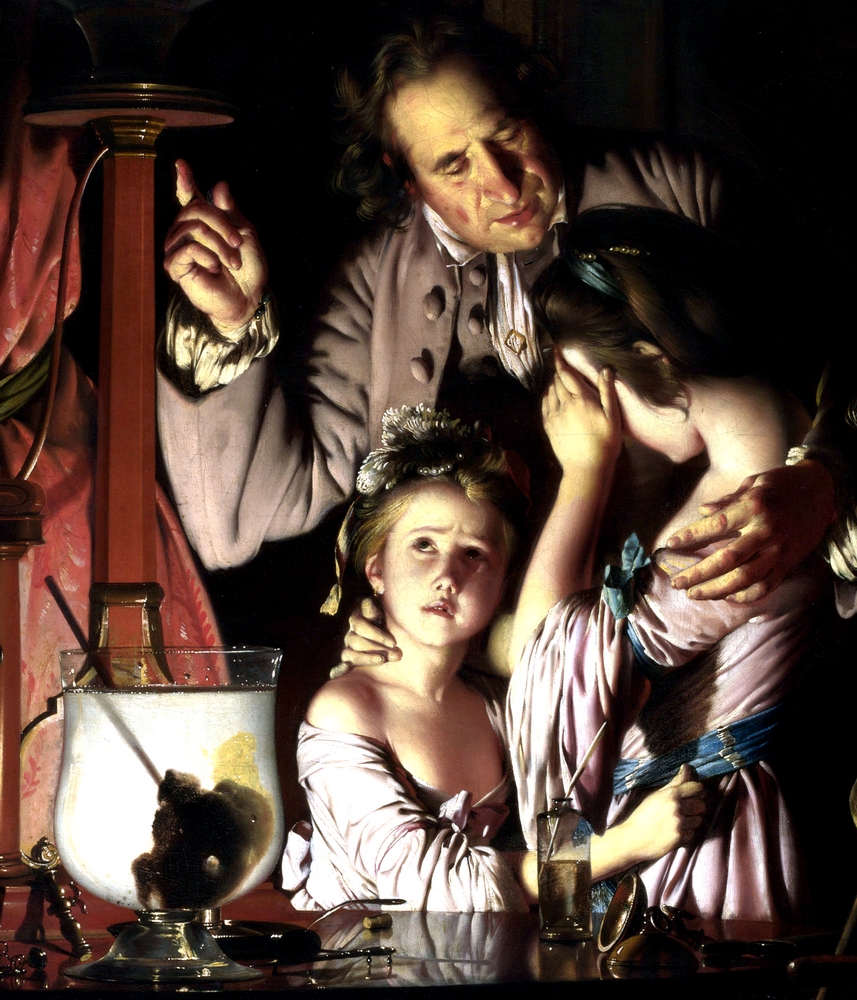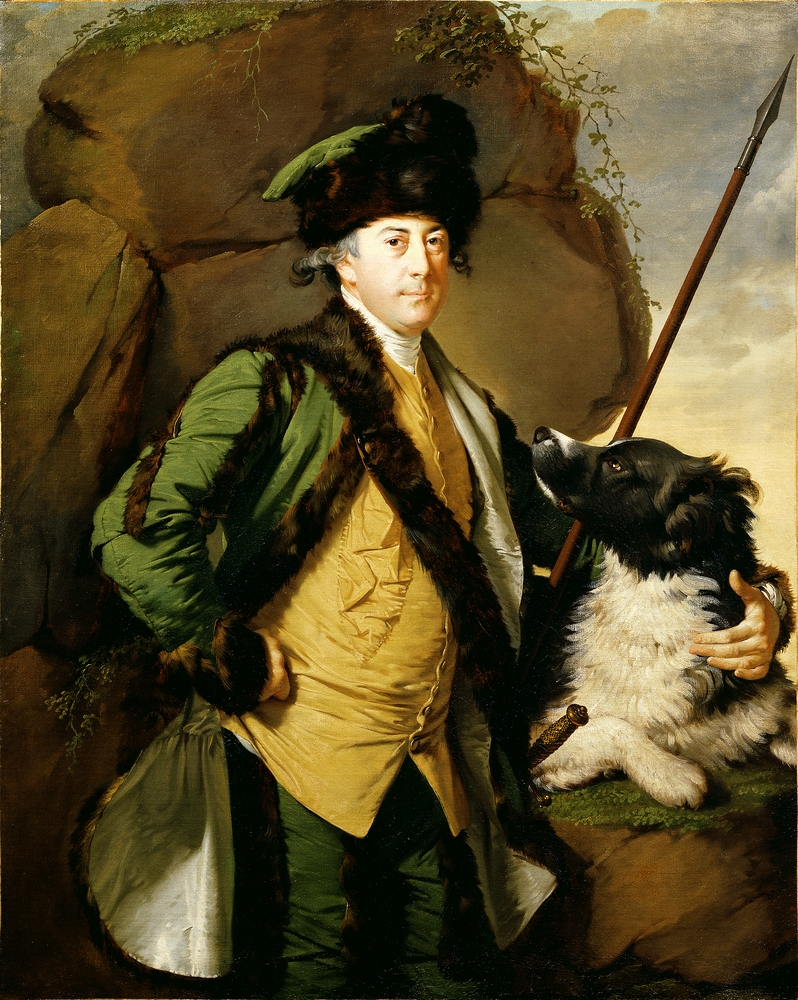Joseph Wright of Derby

Joseph Wright of Derby (1734 – 1797), was an English landscape and portrait painter. He has been acclaimed as “the first professional painter to express the spirit of the Industrial Revolution”.
Wright is notable for his use of the contrast of light and dark, and, for his paintings of candle-lit subjects. His paintings of the birth of science out of alchemy were often based on the meetings of the Lunar Society of Birmingham, a group of scientists and industrialists who explored new ideas. They are a significant record of the struggle of science against religious values in the period known as the Age of Enlightenment.
Many of Wright’s paintings and drawings are owned by Derby City Council, and are on display at the Derby Museum and Art Gallery.
Two young boys, boldly lit by a concealed candle are inflating a pigs bladder, at the time animal bladders served as toys either inflated and tossed like balloons or filled with dried peas and shaken like rattles. In European art, bladders were often used as symbolic variants on soap bubbles, delicate playthings signifying the fragility of human life and the transience of human achievement. The elaborate costumes worn by the boys were not current clothing and are probably fancy dress outfits, giving an element of style to the picture known at the time as British ‘fancy pictures’.
Probably painted whilst Wright was living and working in Liverpool between 1768 and 1771
the picture is closely connected to the growing provincial culture in the UK during the period. Artists were beginning to achieve success and independence outside London, and their engagement with science and technology was especially strong with the growing cross-currents of ideas between thriving urban hubs like Derby and Liverpool.
Wright uses the illumination of the candlelight to show, in painstaking detail, the play of light upon different surfaces, fabric, faces, the translucent baldder. He follows the meticulous, scientific observation developed in his most iconic larger paintings, this realism strengthens the symbolism, and draws the viewer in to the mystical, symbolic world of the painting.
A partner painting which compares to ‘Two Boys with a Bladder’ in terms conception, and ambition, is “Two Girls Dressing a Kitten by Candlelight” (c.1768-70) The two pictures are exactly the same size, correspond stylistically and have a defined symbolic meaning. Both have a similar composition, the girls are also in costume, and they exemplify Wright’s highly skilful use of paint and his mastery of light effects.
Fancy Pictures
In the 1760’s the genre of ‘fancy pictures’ emerged as one of the most original and popular art forms in Britain. The rise and success of this style was connected to changes in the British artworld, especially the introduction of public art exhibitions, the expansion of the print market, and the subsequent interest of new audiences for art. The fancy picture allowed artists to showcase their skill and invention within this highly competitive environment, whilst also appealing to a broad and lucrative market by rendering new, imaginative subjects.
Representations of children were among the most popular subjects for fancy pictures, and Wright’s painting highlights the intersection between art and enlightenment thinking on child development and education, particularly the new appreciation of games as a playful means for children to develop their independent strengths and capabilities.
Life and Times
Joseph Wright was born in Irongate, Derby, to a respectable family of lawyers. He was the third of five children of Hannah Brookes (1700–1764) and John Wright (1697–1767), an attorney and the town clerk of Derby. Joseph had two elder brothers, and two younger sisters.
Deciding to become a painter, Wright went to London in 1751 and for two years studied under Thomas Hudson, the master of Joshua Reynolds. He returned to, and settled in Derby where he varied his work in portraiture by the production of subjects with strong tenebrism (contrast of light and dark) under artificial light, and by landscape painting. Wright also spent a productive and lucrative period in Liverpool, from 1768 to 1771, mostly painting portraits which included pictures of many prominent citizens and their families.
Wright married Ann Swift, the daughter of a lead miner in 1773. They had six children, three of whom died in infancy. In late 1773 Wright and Ann set off for a painting tour of Italy, with John Downman and Richard Hurleston. Their ship took shelter for three weeks in Nice before finally arriving in Livorno. Although he spent a great deal of time in Naples, Wright never witnessed a major eruption of Mount Vesuvius though he painted this subject many times. It’s probable that he witnessed smaller, less impressive eruptions, which inspired his subsequent paintings.
On his return from Italy he established himself at Bath as a portrait-painter, but this was not financially successful and he returned to Derby in 1777, where he spent the rest of his life. In later years he became increasingly asthmatic and nervous, and for these complaints he was treated by his friend Erasmus Darwin. Ann Wright died in 1790 and Joseph died 1797 having spent his final months with his two daughters.
New Thinking and Influences
Wright was a frequent contributor to the exhibitions of the Society of Artists, and to those of the Royal Academy, of which he was elected an associate in 1781 and a full member in 1784. He, however, declined the latter honour on account of a slight that he believed that he had received, and severed his official connection with the academy, although he continued to contribute to the exhibitions from 1783 until 1794.
Wright is seen at his best in his candlelit subjects of which the ‘Three Persons Viewing the Gladiator by Candlelight’ (1765), his ‘A Philosopher Lecturing on the Orrery’ (1766), and ‘An Experiment on a Bird in the Air Pump’ (1768), The Alchemist in Search of the Philosopher’s Stone (1771), are excellent examples.


‘Cave at Evening’ uses the same dramatic chiaroscuro and was painted in 1774 during his time in Italy, as was his ‘Old Man and Death’ (1774) a striking and highly individual piece of work.
His landscape subjects also made creative use of light and dark ‘Dovedale by Moonlight’, capturing the rural landscape of Dovedale valley lit by a full moon. It’s companion piece, ‘Dovedale by Sunlight’ (circa 1784–1785) captures the colors of day. In another painting, ‘Moonlight Landscape’, equally dramatic, the Moon is obscured by an arched bridge over water, but illuminates the scene, making the water sparkle in contrast to the dusky landscape.
Painting and the Age of Enlightenment

Wright had close contact with the pioneering industrialists of the Midlands. Two of his most important patrons were Josiah Wedgwood, who industrialised the manufacture of pottery, and Richard Arkwright, who created the factory system in the cotton industry. Wright also had connections with Erasmus Darwin and other members of the Lunar Society, which brought together leading industrialists, scientists, and philosophers. Although meetings were held in Birmingham, Erasmus Darwin, grandfather of Charles Darwin, lived in Derby, and some of the paintings by Joseph Wright of Derby, notable for their use of brilliant light on shade, were inspired by Lunar Society gatherings.


‘An Experiment on a Bird in the Air Pump’ (1768), shows people gathered to observe an early experiment into the nature of air and its ability to support life.


‘The Alchemist in Search of the Philosopher’s Stone’ (1771) portrays the discovery of the element phosphorus by German alchemist Hennig Brand in 1669. A flask in which a large quantity of urine has been boiled down is seen bursting into light as the phosphorus, which is abundant in urine, ignites spontaneously in air.
‘A Philosopher Lecturing on the Orrery’ shows an early mechanism for demonstrating the movement of the planets around the Sun. The Scottish scientist James Ferguson (1710–1776) gave a series of lectures in Derby in July 1762 based on his book Lectures on Select Subjects in Mechanics, Hydrostatics, Pneumatics, Optics &c. (1760). To illustrate his lectures, Ferguson used various machines, models, and instruments. Wright probably attended these talks and they must have inspired his painting.

These very large factual paintings are considered to have metaphorical meaning too, the bursting into light of the phosphorus in front of a praying figure signifying the problematic transition from faith to scientific understanding and enlightenment, and the various expressions on the figures around the bird in the air pump indicating concern over the possible inhumanity of the coming age of science.
These paintings represent a high point in scientific enquiry that began to undermine the power of religion in Western societies. It was a period of great unrest and some ten years later, scientists would find themselves persecuted in the backlash to the French Revolution of 1789. In Britain, Mobs attacked laboratories and drove many scientists and philosophers into hiding. In France, the chemist Antoine Lavoisier was executed by the guillotine at the height of the Terror. The politician and philosopher Edmund Burke, in his famous ‘Reflections on the Revolution in France’ (1790), linked natural philosophers to the French Revolution; It was against this background that Charles Darwin, grandson of the Derby man and Lunar Society member, Erasmus Darwin, would add to the conflict between science and religious belief, half a century later, with the publication of his book The Origin of Species in 1859.










